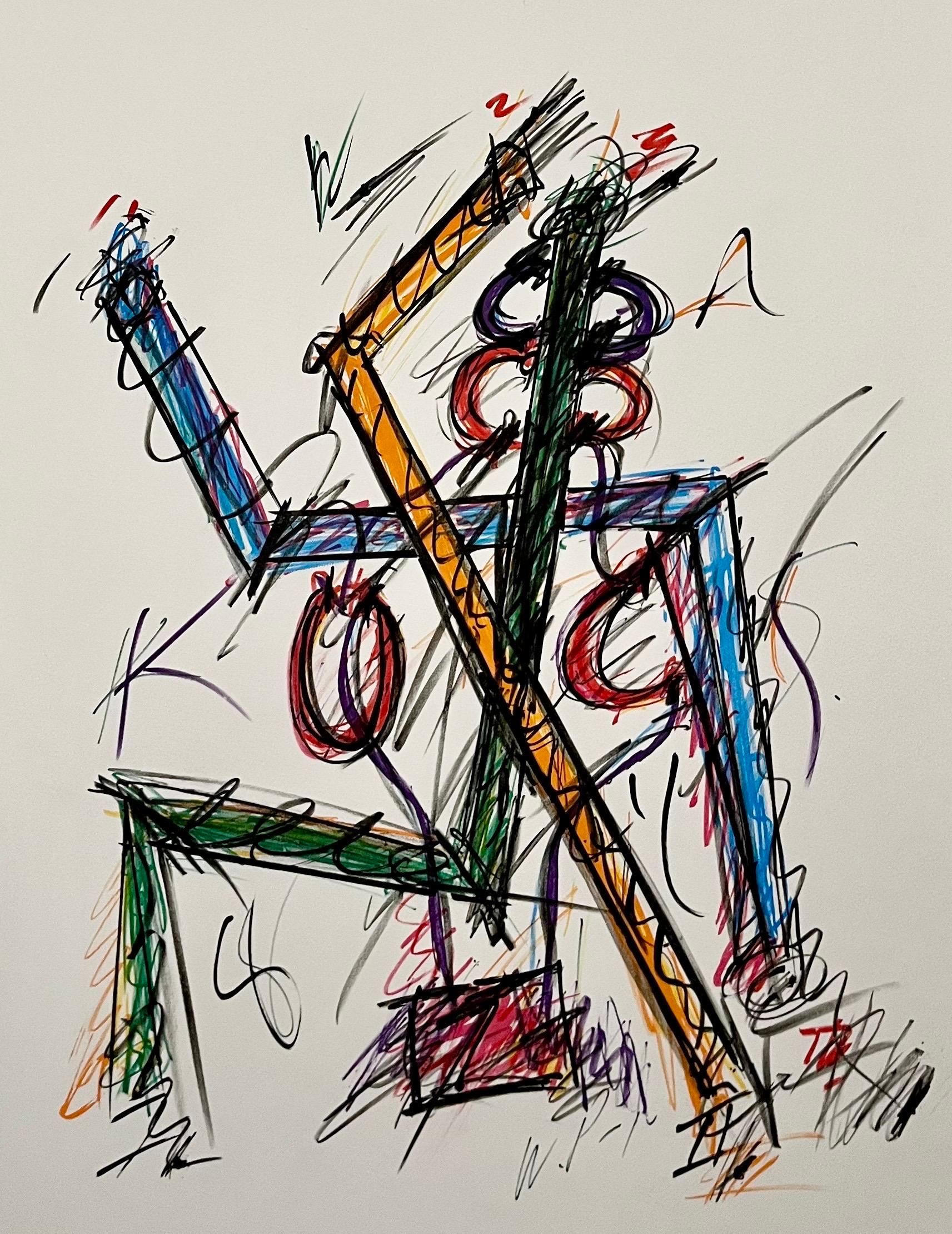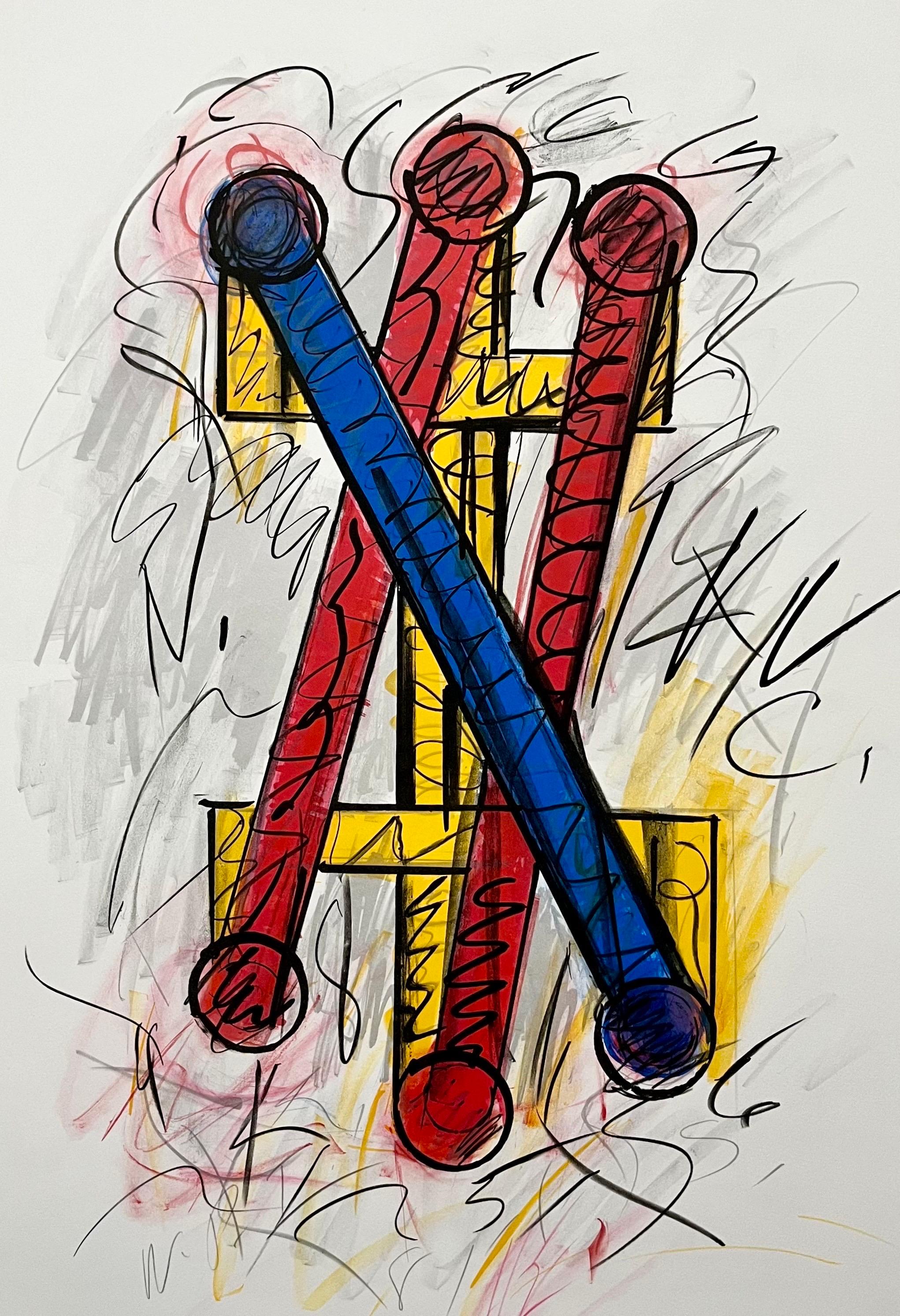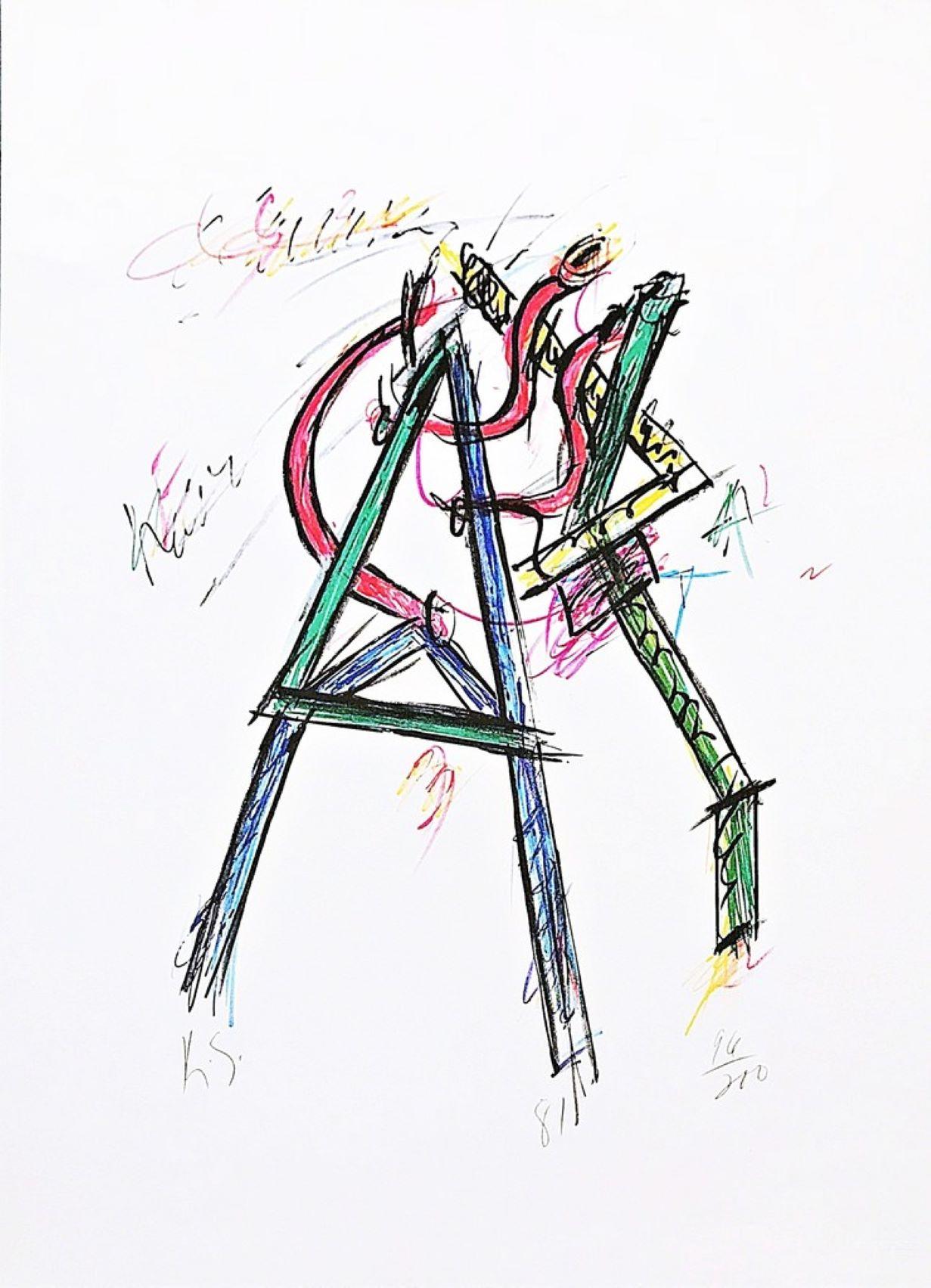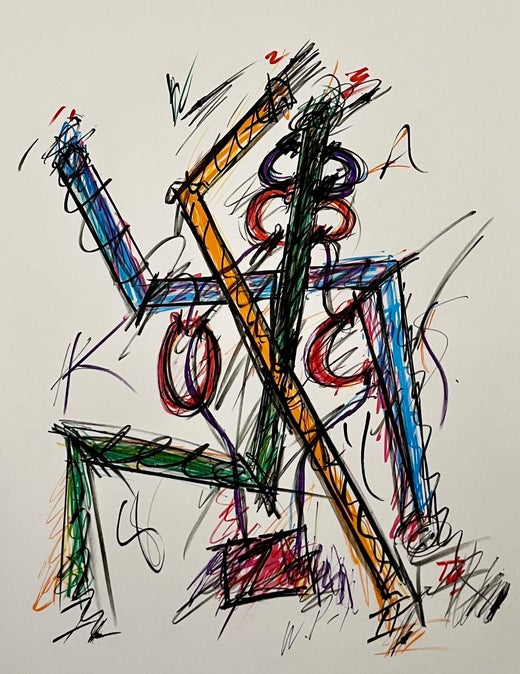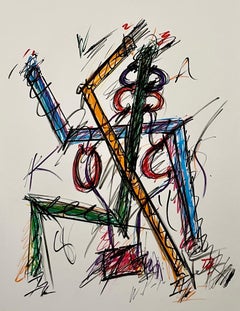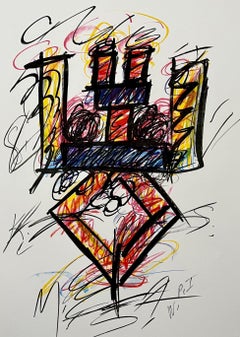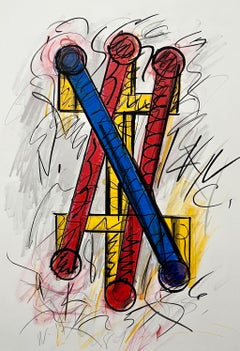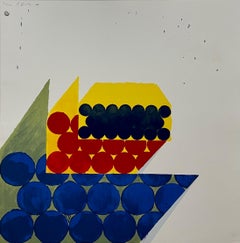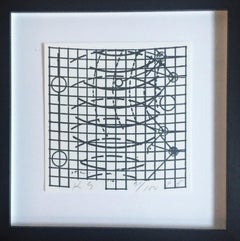Items Similar to 1981 American Post Minimalist Abstract Art Lithograph Neon Series Keith Sonnier
Want more images or videos?
Request additional images or videos from the seller
1 of 8
Keith Sonnier1981 American Post Minimalist Abstract Art Lithograph Neon Series Keith Sonnier1981
1981
$750
£583.93
€664.09
CA$1,078.85
A$1,185.31
CHF 619.45
MX$14,135.82
NOK 7,843.93
SEK 7,307.28
DKK 4,962.40
About the Item
Keith Sonnier, American (1941-2020)
lithograph
From Neon series
circa 1980-1981
Bears the Waterstreet Press watermarks and Arches paper blind stamp to lower right corner. Pub. Edizioni Lucio Amelio
Hand signed with initials in pencil
Dimensions: 30 x 21 3/4 inches
Post minimalist Abstract by Keith Sonnier
Keith Sonnier (1941 – 2020) was a post minimalist sculptor, performance artist, video and light artist. Sonnier was one of the first artists to use light in sculpture in the 1960s. With his use of neon in combination with ephemeral materials he achieved international recognition. Sonnier was part of the Process Art movement.
James Keith Sonnier was born July 31, 1941, in Mamou, Louisiana. His family was Cajun and Roman Catholic. His father was a hardware store owner, Joseph Sonnier, and his mother was a florist and singer, Mae Ledoux. He graduated in 1963 from Southwestern Louisiana Institute (now known as the University of Louisiana at Lafayette). In 1966, he graduated with his MFA degree from Rutgers University, where he studied under Allan Kaprow, Robert Watts, and Robert Morris. After graduation from Rutgers, he moved to New York City with Jackie Winsor and some of his former classmates.
Sonnier died in Southampton, NY on July 18, 2020.
Sonnier began experimenting with neon in 1968. Neon lights became a signature material used in his sculptural works. The common materials Sonnier employed included neon and fluorescent lights; reflective materials; aluminum and copper; and glass and wires. Of the generation of James Turrell and Dan Flavin, He was also associated with the Light and Space movement, a loosely affiliated art movement related to op art, minimalism and geometric abstraction originating in Southern California in the 1960s and influenced by John McLaughlin. It is characterized by a focus on perceptual phenomena, such as light, volume and scale, and the use of materials such as glass, neon, fluorescent lights, resin and cast acrylic, often forming installations conditioned by the work's surroundings. Artists included Ron Cooper, Mary Corse, Maria Nordman, Eric Orr, Keith Sonnier and James Turrell. In 1966 he married the sculptor Jackie Winsor, who at the time was a fellow art student from Rutgers University. Contemporary sculptors and postminimalist artists: Bruce Nauman, Eva Hesse, Richard Tuttle, Barry LeVa. He also published with Styria Studio during the 1980s. This bears the hallmarks of the bright colors of that period seen in the works of Ettore Sottsass, Peter Shire and the Memphis Milano artists. He was included in The New York Collection for Stockholm, 1973 with Lee Bontecou, John Chamberlain, Mark di Suvero, Jim Dine, Öyvind Fahlström, Dan Flavin, Red Grooms, Donald Judd, Ellsworth Kelly, Roy Lichtenstein, Sol LeWitt, Robert Morris, Louise Nevelson, Kenneth Noland, Claes Oldenburg, Nam June Paik, Robert Rauschenberg, James Rosenquist, George Segal, Richard Serra, Keith Sonnier, Richard Stankiewicz, Cy Twombly and Andy Warhol
- Creator:Keith Sonnier (1941, American)
- Creation Year:1981
- Dimensions:Height: 30 in (76.2 cm)Width: 21.75 in (55.25 cm)
- Medium:
- Movement & Style:
- Period:
- Condition:Minor wear. Refer to photos.
- Gallery Location:Surfside, FL
- Reference Number:1stDibs: LU38214931802
Keith Sonnier
Keith Sonnier was a postminimalist sculptor, performance artist, video and light artist. Sonnier was one of the first artists to use light in sculpture in the 1960s. With his use of neon in combination with ephemeral materials he achieved international recognition. Sonnier was part of the Process Art movement.
About the Seller
4.9
Platinum Seller
Premium sellers with a 4.7+ rating and 24-hour response times
Established in 1995
1stDibs seller since 2014
1,836 sales on 1stDibs
Typical response time: 1 hour
- ShippingRetrieving quote...Shipping from: Surfside, FL
- Return Policy
More From This Seller
View All1981 American Post Minimalist Abstract Art Lithograph Neon Series Keith Sonnier
By Keith Sonnier
Located in Surfside, FL
Keith Sonnier, American (1941-2020)
lithograph
From Neon series
circa 1980-1981
Bears the Waterstreet Press watermarks and Arches paper blind stamp to lower right corner. Pub. Edizioni Lucio Amelio
Hand signed with initials in pencil
Dimensions: 30 x 21 3/4 inches
Post minimalist Abstract by Keith Sonnier
Keith Sonnier (1941 – 2020) was a post minimalist sculptor, performance artist, video and light artist. Sonnier was one of the first artists to use light in sculpture in the 1960s. With his use of neon in combination with ephemeral materials he achieved international recognition. Sonnier was part of the Process Art movement.
James Keith Sonnier was born July 31, 1941, in Mamou, Louisiana. His family was Cajun and Roman Catholic. His father was a hardware store owner, Joseph Sonnier, and his mother was a florist and singer, Mae Ledoux. He graduated in 1963 from Southwestern Louisiana Institute (now known as the University of Louisiana at Lafayette). In 1966, he graduated with his MFA degree from Rutgers University, where he studied under Allan Kaprow, Robert Watts, and Robert Morris. After graduation from Rutgers, he moved to New York City with Jackie Winsor and some of his former classmates.
Sonnier died in Southampton, NY on July 18, 2020.
Sonnier began experimenting with neon in 1968. Neon lights became a signature material used in his sculptural works. The common materials Sonnier employed included neon and fluorescent lights; reflective materials; aluminum and copper; and glass and wires. Of the generation of James Turrell and Dan Flavin, He was also associated with the Light and Space movement, a loosely affiliated art movement related to op art, minimalism and geometric abstraction originating in Southern California in the 1960s and influenced by John McLaughlin. It is characterized by a focus on perceptual phenomena, such as light, volume and scale, and the use of materials such as glass, neon, fluorescent lights, resin and cast acrylic, often forming installations conditioned by the work's surroundings. Artists included Ron Cooper...
Category
1980s Post-Minimalist Abstract Prints
Materials
Paper, Lithograph
1981 American Post Minimalist Abstract Art Lithograph Neon Series Keith Sonnier
By Keith Sonnier
Located in Surfside, FL
Keith Sonnier, American (1941-2020)
lithograph
From Neon series
circa 1980-1981
Bears the Waterstreet Press watermarks and Arches paper blind stamp to lower right corner. Pub. Edizioni Lucio Amelio
Hand signed with initials in pencil
Dimensions: 30 x 21 3/4 inches
Post minimalist Abstract by Keith Sonnier
Keith Sonnier (1941 – 2020) was a post minimalist sculptor, performance artist, video and light artist. Sonnier was one of the first artists to use light in sculpture in the 1960s. With his use of neon in combination with ephemeral materials he achieved international recognition. Sonnier was part of the Process Art movement.
James Keith Sonnier was born July 31, 1941, in Mamou, Louisiana. His family was Cajun and Roman Catholic. His father was a hardware store owner, Joseph Sonnier, and his mother was a florist and singer, Mae Ledoux. He graduated in 1963 from Southwestern Louisiana Institute (now known as the University of Louisiana at Lafayette). In 1966, he graduated with his MFA degree from Rutgers University, where he studied under Allan Kaprow, Robert Watts, and Robert Morris. After graduation from Rutgers, he moved to New York City with Jackie Winsor and some of his former classmates.
Sonnier died in Southampton, NY on July 18, 2020.
Sonnier began experimenting with neon in 1968. Neon lights became a signature material used in his sculptural works. The common materials Sonnier employed included neon and fluorescent lights; reflective materials; aluminum and copper; and glass and wires. Of the generation of James Turrell and Dan Flavin, He was also associated with the Light and Space movement, a loosely affiliated art movement related to op art, minimalism and geometric abstraction originating in Southern California in the 1960s and influenced by John McLaughlin. It is characterized by a focus on perceptual phenomena, such as light, volume and scale, and the use of materials such as glass, neon, fluorescent lights, resin and cast acrylic, often forming installations conditioned by the work's surroundings. Artists included Ron Cooper...
Category
1980s Post-Minimalist Abstract Prints
Materials
Paper
1981 American Post Minimalist Abstract Art Lithograph Neon Series Keith Sonnier
By Keith Sonnier
Located in Surfside, FL
Keith Sonnier, American (1941-2020)
lithograph
From Neon series
circa 1980-1981
Bears the Waterstreet Press watermarks and Arches paper blind stamp to lower right corner. Pub. Edizioni Lucio Amelio
Hand signed with initials in pencil
Dimensions: 30 x 21 3/4 inches
Post minimalist Abstract by Keith Sonnier
Keith Sonnier (1941 – 2020) was a post minimalist sculptor, performance artist, video and light artist. Sonnier was one of the first artists to use light in sculpture in the 1960s. With his use of neon in combination with ephemeral materials he achieved international recognition. Sonnier was part of the Process Art movement.
James Keith Sonnier was born July 31, 1941, in Mamou, Louisiana. His family was Cajun and Roman Catholic. His father was a hardware store owner, Joseph Sonnier, and his mother was a florist and singer, Mae Ledoux. He graduated in 1963 from Southwestern Louisiana Institute (now known as the University of Louisiana at Lafayette). In 1966, he graduated with his MFA degree from Rutgers University, where he studied under Allan Kaprow, Robert Watts, and Robert Morris. After graduation from Rutgers, he moved to New York City with Jackie Winsor and some of his former classmates.
Sonnier died in Southampton, NY on July 18, 2020.
Sonnier began experimenting with neon in 1968. Neon lights became a signature material used in his sculptural works. The common materials Sonnier employed included neon and fluorescent lights; reflective materials; aluminum and copper; and glass and wires. Of the generation of James Turrell and Dan Flavin, He was also associated with the Light and Space movement, a loosely affiliated art movement related to op art, minimalism and geometric abstraction originating in Southern California in the 1960s and influenced by John McLaughlin. It is characterized by a focus on perceptual phenomena, such as light, volume and scale, and the use of materials such as glass, neon, fluorescent lights, resin and cast acrylic, often forming installations conditioned by the work's surroundings. Artists included Ron Cooper...
Category
1980s Post-Minimalist Abstract Prints
Materials
Paper, Lithograph
Abstract Minimalist Color Silkscreen Print Richard Smith On The Bowery Pop Art
By Richard Smith
Located in Surfside, FL
Richard Smith
On the Bowery, 1969 - 1971
silkscreen on Schoeller's Parole Paper, edition of 100 + 20 A.P.
25.5 x 25.5 inches, signed, numbered 21/100
Screenprint in color on wove pa...
Category
1960s Pop Art Abstract Prints
Materials
Lithograph, Screen
Original Abstract Collage Painting British American Pop Artist Richard Smith
By Richard Smith
Located in Surfside, FL
Richard Smith, British (1931-2016)
Untitled (Abstract Composition) (1976)
Gouache, crayon, charcoal and metal staples on Arches paper
Hand signed lower center
sheet: 22 x 22 inches
...
Category
1970s Minimalist Abstract Paintings
Materials
Metal
1980s Abstract Expressionism Color Field Silkscreen Serigraph Print Pale Yellow
By Michael Steiner
Located in Surfside, FL
Michael Steiner, American, New York City (1945 - )
this is 49 of 160 from the edition.
Michael Steiner A leading member of the Bennington school, abstract artists associated with ...
Category
1970s Abstract Expressionist Abstract Prints
Materials
Screen
You May Also Like
Untitled sculptural image signed/n lithograph by famed post Minimalist sculptor
By Keith Sonnier
Located in New York, NY
Keith Sonnier
Untitled sculptural image, 1981
Lithograph on wove paper
Signed, numbered 156/200 and dated in graphite pencil on the front
Published by Waterstreet Press with blind st...
Category
1980s Post-Minimalist Abstract Prints
Materials
Graphite, Lithograph
Untitled post Minimalist sculptural lithograph by renowned sculptor (signed/N)
By Keith Sonnier
Located in New York, NY
Keith Sonnier
Untitled post Minimalist lithograph, 1981
Lithograph on watermarked paper with publishers blind stamp
Pencil signed, numbered 96/200 and dated on the front
Published by...
Category
1980s Post-Minimalist Abstract Prints
Materials
Graphite, Lithograph
Untitled sculptural lithograph (signed/numbered) by renowned sculptor
By Keith Sonnier
Located in New York, NY
Keith Sonnier
Untitled sculptural lithograph, 1981
Lithograph on watermarked paper
Signed, numbered 159/200 and dated in graphite pencil on the front
Published by Waterstreet Press
...
Category
1980s Post-Minimalist Abstract Prints
Materials
Graphite, Lithograph
Untitled limited edition signed abstract geometric print by renowned sculptor
By Keith Sonnier
Located in New York, NY
KEITH SONNIER
Untitled, 1995
Letterpress on Sumerset Paper
Edition 91/100
Signed and numbered in graphite from the edition of 100, recto
Frame included
Measurements:
Sheet: 6 inches ...
Category
1990s Contemporary Abstract Prints
Materials
Mixed Media, Pencil, Lithograph
NYC - Tokyo
By Keith Sonnier
Located in New Orleans, LA
Keith Sonnier (1940-2020, Louisiana) is best known for radically reinventing the art of sculpture in the late 1960s. He employed unusual materials that had never been used before, ca...
Category
Late 20th Century Post-Minimalist Abstract Drawings and Watercolors
Materials
Paper, Mixed Media
$22,000
Elliptical Orbit
By Keith Sonnier
Located in New York, NY
Keith Sonnier
Elliptical Orbit, 1991
Silver aluminum sheet, silkscreened with oil based inks
48 x 24 inches
Edition of 6, with 3 AP
Signed recto
Category
Late 20th Century Contemporary Mixed Media
Materials
Ink
More Ways To Browse
Vintage Neon Lights
Vintage Fluorescent Lights
Lucio Amelio
Jasper Johns Whitney
Jaune Quick To See Smith
Joan Miro Quelque Fleur Pour Des Amis
Joan Miro Revolutions Sceniques Du Xxe Siecle I
Jorg Schmeisser
Josef Albers Yellow
Kandinsky And Etching
Kaws Snoopy
Krakow Vintage Poster
Lennart Nystrom
Lichtenstein Silkscreen
Luciano Castelli
Milan Lukac
Motherwell Africa Suite
Mourlot Corbusier
